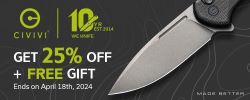We independently evaluate all recommended products and services. Any products or services put forward appear in no particular order. If you click on links we provide, we may receive compensation.
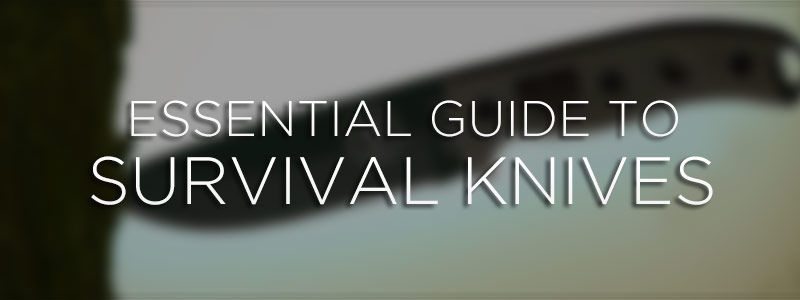
I get a lot of questions from readers asking about survival knives. Whether you’re headed into the wilderness or simply preparing for the next apocalypse, a folding knife will serve you well but a good survival knife makes all the difference. In my own search for the best survival knife over the years I’ve had plenty of experience with the top sellers and wanted to share my opinions with you all.
In a hurry? We love all the knives recommended here but if you asked us to recommend one survival knife we usually lean towards the ESEE 6P. A well-priced all-round knife and deserving of our top pick.
When you’re caught out in the wild and things are getting serious, a quality survival knife is a crucial tool to have with you and can be used for a wide variety of survivalist tasks from building a shelter, skinning game, splitting firewood, cutting rope, opening cans, and much more. Now, before you shell out you’re hard earned coins it’s important to know what to look for. I discuss the general rules of buying a good survival knife below and then share my own list of the top survival knives currently on the market.
The 6 Rules of Buying a Survival Knife
Rule #1: Fixed blade, not folding
My passion in life is folding knives but I stand by this statement when it comes to survival knives. A good folding knife is perfect for everyday carry, but in a survival situation you want a fixed blade. Part of the reason for this is that the joint (or pivot) of a folding knife is a weakness when it comes to the rough abuse your survival knife will endure.
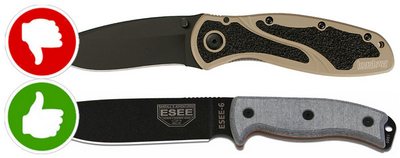 In a survival knife, you want something that will be readily available for chopping, thrusting, prying, pounding, and rigorous cutting. Hence for survival, folding knives just don’t…well…cut it.
In a survival knife, you want something that will be readily available for chopping, thrusting, prying, pounding, and rigorous cutting. Hence for survival, folding knives just don’t…well…cut it.
Yes, I know that there are folding knives advertised as survival knives and many of the best folding knives are damn solid, so why do I insist on a fixed blade? Look, many folders are indeed tough but they’ll never take a beating like a solid fixed blade. Another reason is speed of deployment. With a folding blade, you have to open the knife and ensure it is properly locked before you can use it. In an emergency situation, you want a knife that is ready to go the minute you pull it out of its sheath. When speed and safety are essential, a fixed blade knife is much better than a folder.
Rule #2: Full tang is the way to go
A “full tang” means that the blade extends the entire length of the knife, from the tip to the very end of the handle. It’s essential for the providing the strength you’ll need in many survival situations.
 A partial tang is simply too flimsy in situations where you need to force the blade against a hard object, or use the knife as a prying tool. The full tang knife is going to be much more effective for prying or digging. Of course, this all comes at price in the weight of the knife but 9 times out of 10 I would stick with the full tang.
A partial tang is simply too flimsy in situations where you need to force the blade against a hard object, or use the knife as a prying tool. The full tang knife is going to be much more effective for prying or digging. Of course, this all comes at price in the weight of the knife but 9 times out of 10 I would stick with the full tang.
The other problem with partial tang knives is that the blades can loosen and develop “play” in the handle, which becomes quite dangerous. With a full tang knife, even if the handle becomes damaged or falls off, you can wrap the tang in parachute cord or rope and still have a fully usable tool. Not so with partial tang knives. Trust me.
Rule #3: A high carbon blade steel
If you’ve read my essential guide to knife steel you’ll know that there’s a boat load of different steels on the market today. When it comes to your survival knife you don’t want to cheap out on a $20 Chinese-made knife from eBay with soft steel that won’t hold its edge. This knife may one day be the difference between life and death so give it some respect.
 You need to shop around and find a blade that uses a quality steel alloy. For EDC knives, I usually recommend to stick with stainless steel. This is because EDC knives are used far more frequently than my survival knife, so a low maintenance stainless steel is preferred.
You need to shop around and find a blade that uses a quality steel alloy. For EDC knives, I usually recommend to stick with stainless steel. This is because EDC knives are used far more frequently than my survival knife, so a low maintenance stainless steel is preferred.
Since my survival knives are used less frequently, but also subject to more heavy duty usage, I generally recommend a knife made with carbon steel over stainless. Carbon steel is tougher than your average stainless steel and will hold up to the abuse more. You just have to remember to take good care of these knives, or they’ll rust and stain. The most popular carbon steel often used in survival knives is called 1095, or slight variants thereof. It’s a great steel for your survival knife because it’s not only tough but easy to sharpen too.
If you insist on not having to lubricate your knife to keep it corrosion free, I’d recommend a blade made of AUS–8, 440C or 420HC stainless steel. Each of these alloys is different, but they’ll hold a decent edge while still staying easy to sharpen. If you have more to spend consider a higher end steel like S30V which will hold its edge for longer.
Rule #4: Blade length 4 – 7 inches
Size matters, as my wife always tells me, but bigger is not always better in the survival game. For example, just as a blade that is too thick can make it difficult to dress small game or carve precision snares, so can a blade that is too long. On the other hand, if your knife isn’t long enough, you won’t be able to use it effectively for chopping or batoning, which is striking the back of your knife blade with something like a rock or chunk of wood in order to drive the blade through a thick branch or stubborn piece of wood. You want a blade that’s long enough to do what you need it to do, but not so long that it gets in your way. Ahh, life’s little trade offs.
 Most survival knives fall in the range of six to 12 inches, but remember that you aren’t hunting elephants. Anything bigger than 10 or 11 inches runs towards being too long to really be useful in as many situations as possible. The knife becomes too big to handle and carry effectively, and can easily present itself as a hindrance to your survival instead of a tool to ensure it.
Most survival knives fall in the range of six to 12 inches, but remember that you aren’t hunting elephants. Anything bigger than 10 or 11 inches runs towards being too long to really be useful in as many situations as possible. The knife becomes too big to handle and carry effectively, and can easily present itself as a hindrance to your survival instead of a tool to ensure it.
I recommend keeping the blade between 4 and 7 inches, with an overall length of around 10 to 11 inches. With that said, you’ll find several of my favorites run past 11 inches, but just barely. It all comes down to what you’re comfortable carrying and working with, and I’m a beefy enough guy that the knives running close to 12 inches are still effective for me to use. Anything longer is basically a machete.
Rule #5: Blade thickness 0.17 – 0.25 inches
When you’re shopping for a survival knife, you might be worried about keeping your encumbrance down. After all, you don’t want to be carrying any more weight than necessary, so you might be tempted to shop for a survival knife with a thin blade to cut down on the heaviness.
 This is not always a good idea, for a number of reasons. The biggest reason is that you don’t just need a good blade, but you also need one that is going to be useful for as many jobs as possible. One minute, you might find yourself using the survival knife to skin a rabbit, but the next minute you’ll be batoning wood and that’s where the extra thickness is going to come in handy.
This is not always a good idea, for a number of reasons. The biggest reason is that you don’t just need a good blade, but you also need one that is going to be useful for as many jobs as possible. One minute, you might find yourself using the survival knife to skin a rabbit, but the next minute you’ll be batoning wood and that’s where the extra thickness is going to come in handy.
Bending is absolutely undesirable in a survival knife, so you need some girth to the blade’s thickness. At the same time, you don’t want the blade so thick that you can’t use it for delicate work like skinning game or carving snare sets. The sweet spot? Look for a thickness between 0.17 and 0.25 inches.
Rule #6: A solid, synthetic handle
It’s easy to focus on the blade and getting the most out of it, but remember that you have to hold and use the survival knife in inclement weather, more often than not. The handle will also take a bit of a beating when you’re using your knife for batoning wood or prying objects loose.
 The most important things to look at in the survival knife’s handle are strength, durability, and grip.
The most important things to look at in the survival knife’s handle are strength, durability, and grip.
Stay away from hollow, cheap plastic or metal handles in your survival knife. It might sound cool to be able to carry matches or fishing line and hooks inside your knife handle, but that lack of density seriously compromises the strength of the knife. If your survival knife is hard to hold or lacks strength and durability, it can quickly become a liability with the cost of you injuring yourself. Metal handles conduct heat and can make for an ice cold grip in the winter wilderness.
The best materials for a survival knife handle are typically made from your modern synthetics – Kraton (a synthetic rubber polymer), Micarta, G-10, GRN/FRN (glass/fiber reinforced nylon with brands like Zytel or Valox), or even just dense rubber. These materials are near indestructible and provide durability, and grip (read more in our guide to knife handle materials). Look for texturing and scales too, giving you plenty of comfortable grip. Don’t let the traditionalists talk you out of this – synthetics are the way to go. I also like to have a blunt end for hammering, and hopefully even a lanyard hole for keeping the knife readily accessible from around your wrist.
Considering one of those Commando knives with a built in compass and you can store stuff inside the handle? Stay well away, it’s more trouble than it’s worth.
![]()
Our favorite survival knives in 2024
Okay here’s our pick of the best survival knives on the market today. All of these knives meet the rules of survival knife buying described above aside for a few exceptional cases where I feel the knife on the whole is worthy of inclusion.
| Make/Model | Image | Price | Steel | Handle | Blade (in) | Overall (in) | Weight (oz) | Thickness (in) | Tang | Origin |
|---|---|---|---|---|---|---|---|---|---|---|
| Survive Knives GSO 5.1 |  | $$$$$ | CPM-3V | G-10 | 5.8 | 11.4 | 12.7 | 0.19 | Full | USA |
| Fallkniven A1 |  | $$$$ | VG-10 | Kraton | 6.3 | 11.0 | 12.0 | 0.24 | Full | USA |
| TOPS BOB |  | $$$$ | 154CM | Micarta | 4.6 | 9.9 | 9.9 | 0.19 | Full | USA |
| Ontario Blackbird |  | $$$ | 154CM | G-10 | 5.0 | 10.0 | 8.4 | 0.13 | Full | USA |
| Fallkniven S1 |  | $$$ | VG-10 | Thermorun | 5.1 | 9.7 | 6.7 | 0.20 | Full | USA |
| Benchmade Leuku |  | $$$ | CPM-3V | Santoprene | 5.2 | 9.7 | 5.3 | 0.14 | Full | USA |
| ESEE 5 |  | $$$ | 1095 | Micarta | 5.3 | 11.0 | 15.9 | 0.25 | Full | USA |
| ESEE 6 |  | $$ | 1095 | Micarta | 6.5 | 11.8 | 11.8 | 0.19 | Full | USA |
| Ka-Bar Becker BK2 |  | $$ | 1095 Cro-Van | Zytel | 5.3 | 10.5 | 16.0 | 0.25 | Full | USA |
| Gerber LMF II |  | $$ | 420HC | GFN | 4.8 | 10.6 | 11.7 | 0.19 | Partial (80%) | USA |
| Ontario RAT 7 |  | $ | 1095 | Micarta | 7.0 | 12.3 | 12.6 | 0.19 | Full | USA |
| Ontario RAT 5 |  | $ | 1095 | Micarta | 5.0 | 10.5 | 11.5 | 0.19 | Full | USA |
| Morakniv Garberg |  | $ | 14C28N | Polymer | 4.3 | 9.0 | 6.0 | 0.12 | Full | Sweden |
| Condor Bushlore |  | $ | 1075 | Micarta | 4.3 | 9.3 | 8.0 | 0.13 | Full | El Salvador |
| Gerber StrongArm |  | $ | 420HC | Rubber | 4.9 | 9.8 | 7.1 | 0.19 | Full | USA |
| Cold Steel SRK |  | $ | SK-5 | Polymer | 6.0 | 10.8 | 8.2 | 0.20 | Full | Taiwan |
Top Pick
ESEE 6P

6.5″
11.8″
11.8 oz
1095
Micarta
USA
Perhaps my all-around favorite survival knife, the ESEE 6P is a plain edge survival knife made from high carbon 1095 steel. This full tang knife is a beauty, and I find myself using it more than my other favorite the KA-BAR Becker 22. ESEE makes plenty of fine knives, and the 6P is an example of the best they have to offer. The knife itself is available in a variety of appearances, such as a venom green blade with orange handles or the standard black powdered blade with a gray handle.
 ESEE has built the 6P to be a beast of a knife at 11.75 inches long, so a little on the longer side, with a blade length of 6.5 inches. The cutting edge is 5.75 inches, the blade is relatively slim at 0.19 inches, and the tang is provided with an excellent finger hole just above the handle for those times that you want to choke up a bit on the knife but still be safe. The total weight of the 6P is a mere 12 ounces, so the knife feels great in your hand but is still heavy enough to really take some use and abuse.
ESEE has built the 6P to be a beast of a knife at 11.75 inches long, so a little on the longer side, with a blade length of 6.5 inches. The cutting edge is 5.75 inches, the blade is relatively slim at 0.19 inches, and the tang is provided with an excellent finger hole just above the handle for those times that you want to choke up a bit on the knife but still be safe. The total weight of the 6P is a mere 12 ounces, so the knife feels great in your hand but is still heavy enough to really take some use and abuse.
The drop point blade is flat-ground, easy to sharpen, and the black powder finish holds quite well. Again, the one thing to remember about 1095 steel is that it is not stainless, and can rust and stain if you don’t care for it properly (I use a dry film rust inhibitor).
The blade comes razor sharp straight out of the box, and holds its edge remarkably well. The heat treatment ESEE uses on its 1095 steel is among the best in the industry, so while you do need to properly lubricate the knife to prevent rust, you don’t have to go overboard about it. When it comes time to resharpen the blade, you’ll find it pretty easy to do.
The handle of the ESEE 6P is made from gray linen Micarta, a resin handle that is very durable and strong. The rounded pommel includes a lanyard hole, which is almost a must-have in any survival knife. Micarta is an amazing material, since it tends to get even easier to grip when wet, rather than the opposite. This means that when you’re working in inclement weather or sweating heavily, you won’t need to worry about the ESEE 6P slipping out of your hand.

I’ve used ESEE’s 6P knife for just about every imaginable use. Whether I’m splitting firewood or even chopping down wood, the 6P performs flawlessly. Even for kitchen tasks like slicing and chopping meat, fruits, or vegetables, the ESEE 6P is a great tool. The only drawback I’ve found with this survival knife is the type of sheath used. I prefer nylon sheaths that I can attach easily to my belt, but ESEE has chosen instead to include a molded sheath with a clip plate. The sheath is MOLLE-compatible, but it can be a little too complicated for some. On top of that, the material makes quite a bit of noise when removing the knife, which isn’t ideal for you tactical junkies out there. Give me a simple nylon or even leather sheath, please.
Why do I like the ESEE 6P vs the 5P? Simply because the 6P is much lighter than the 5P (11.8 oz vs 15.9 oz). You see, the 5P has a 1/4″ inch thick blade that’s really designed for far more heavy duty tasks. Unless you’re going to be chopping down trees or sculpting your own log cabin it’s really not worth the extra weight gain in my opinion. The 5P being so heavy is far less useful in regular use. The ESEE 6P is very well balanced.
Runner-Up Pick
KA-BAR BECKER BK2 CAMPANION

5.25″
10.5″
16 oz
1095 CroVan
Zytel
USA
The KA-BAR Becker BK2 Campanion has all of the features of an amazing tool for keeping me alive in the outdoors. Designed by Ethan Becker, who founded the Becker Knife and Tool Corporation in the early 1980s, the Becker BK22 Campanion is a superb survival knife from the reputable KA-BAR sold with a heavy-duty polyester sheath. Note it’s also available with a polyester sheath that includes a pouch (model BK22).
 The Becker BK2 Campanion is made in the USA from 1095 Cro-Van carbon steel which is basically standard 1095 steel with added Chromium and Vanadium for improved wear and corrosion resistance. Remember, 1095 steel is a solid choice for knives designed for hard use, but it isn’t stainless steel and it may rust if not properly cared for. It’s also worth noting that the sheath that accompanies the knife is made in China, not the USA.
The Becker BK2 Campanion is made in the USA from 1095 Cro-Van carbon steel which is basically standard 1095 steel with added Chromium and Vanadium for improved wear and corrosion resistance. Remember, 1095 steel is a solid choice for knives designed for hard use, but it isn’t stainless steel and it may rust if not properly cared for. It’s also worth noting that the sheath that accompanies the knife is made in China, not the USA.
The blade is 5.25″ long, the knife’s overall length is 10.5 inches, and the Campanion weighs in at exactly one pound. The BK2 is certainly on the heftier side with its 0.25 inch thick blade but you actually don’t feel it due to the excellent ergonomics. It’s a drop point design for ease of sharpening, with 20-degree edge angles on a flat grind. The blade holds an edge quite nicely, and it sharpens easily. The handle is constructed from Zytel, a Dupont-made glass-reinforced nylon which is damn-near indestructible.
What I really love about the Becker BK2 Campanion is that it balances right at your index finger when you’re holding it right, making the knife feel lighter in your hand. Very few problems with fatigue or hot spots during longer periods of use here, except when you’re trying to perform very intricate carving.
The weight of the knife combined with the thickness of the blade make precise carving tasks somewhat more fatiguing than they would be with a thinner knife blade but it’s worth it for the extra durability. A lanyard hole in the handle makes it easy to attach a rope to this knife for added security in use.
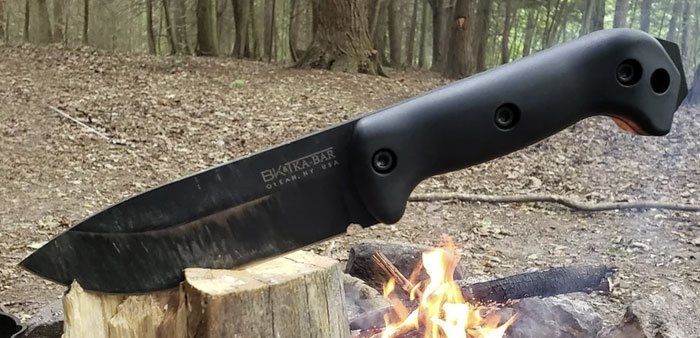
Where the KA-BAR Becker BK2 Campanion really shines is in processing wood. The blade is thick enough that you can baton or pry with confidence, and the flat metal edge at the bottom of the tang is perfect for those times when you might need to drive the knife point-first into a branch or log. The final stroke of genius in this knife is that even after a full day of chopping wood, carving out containers for boiling water, and batoning logs for firewood, the blade was still sharp enough for use in the camp kitchen.
Speaking of the camp kitchen, this knife is brilliant for slicing and dicing onions and potatoes. The thick blade made it a bit more challenging for doing thin slices of spam, unfortunately, but it’s still quite usable for the average camp chef caught without his or her usual cutlery. It just tends to tear through softer meat and other food items, instead of slicing them.
In closing, I can say that the KA-BAR Becker BK2 Campanion is an outstanding utility knife for survival. It’s got its weaknesses, sure, but it’s virtually bombproof in terms of durability and longevity. If you are looking for a solid survival knife that will serve its purpose for many years, you won’t be disappointed with it. Arguably the best fixed blade knife for survival – I’ve had one since it first came out, and it’s pretty much my “go-to” for those deep wilderness treks.
The Rest
GERBER STRONGARM

4.9″
9.8″
7.1 oz
420HC
Rubber
USA
Gerber is known for a lot of things in the knife world, lately with a resurgence in high-quality products after decades of stagnation after the takeover by Fiskars in 1987. But before all the Bear Grylls garbage, they were known for stuff like the Gerber Mark II Fighting Knife, a legendary fixed blade in its own right, and the Gerber LMF infantry knife, a tough as nails do-anything fixed blade. So it is with the StrongArm, a hardcore survival knife that has real design chops but won’t break the bank.
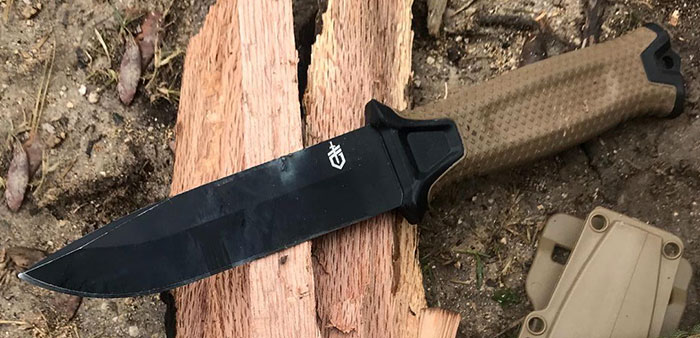
The StrongArm offers a big 4.875” long blade, with a total length of 9.75” – so the 7.2-ounce weight is relatively light, especially considering the beefy 0.19” blade stock. The StrongArm has a molded-in rubberized grip with diamond texturing over its full-tang construction, made from 420HC (high-carbon) steel – a basic tool steel, thus the ceramic blade coating (Cerakote) to prevent rust. You can choose between plain edge or partially serrated models, as well as coyote tan or black rubberized grip areas, all for the same reasonable $75 retail price. They all include a strike pommel at the back with a lanyard hole for easier access.

Speaking of access, the StrongArm’s party trick is its carry system: it includes a 3-way setup, which allows you to carry it vertically in a Molle sheath, horizontally in a traditional belt-loop carry, or suspended in a drop-leg carry with an anti-rattle feature.
COLD STEEL SRK

6.0″
10.8″
8.2 oz
SK-5
Polymer
Taiwan
When you think overbuild hard use tougher than tough knives, Cold Steel has gotta be on your list, right? Of course they are. That’s where the SRK (Survival Rescue Knife) fits in. Offered in two sizes and two steels, the SRK is designed to be adept in all survival roles – in fact, it’s the standard issue knife for the Navy Seals BUDS program, the Basic Underwater Demolition training course.
Available in a 6” blade (10.75” overall) or a “compact” 5” blade (which is 9.5” overall), the SRK models all feature a broad clip point blade profile with a medium-height saber grind for maximum blade strength. The full-sized model has a very wide 0.20” blade at the spine, while the compact is slightly slimmer at 0.16”, but both are stout enough to do a variety of splitting, slicing, skinning, feathering, or slashing through brush. Handles are unique on the SRK, with highly textured Kray-Ex molded polymer scales that wrap all the way around the full-tang handle for a secure, comfortable grip. A bushing passes through both sides of the scales allowing for a solid lanyard attachment as well. The standard SRK uses SK-5 high carbon steel, a relatively uncommon steel, made in Japan and used by both Cold Steel and Ontario in their fixed blade knives. It has 0.9% carbon but only 0.3% chromium so it is rust-prone, which explains the “Tuff-Ex” hardened blade coating.
If you want to spend a bit more, Cold Steel also makes the SRK in high-performance 3V tool steel or a VG-10 San Mai laminate. 3V is pricey – the blade rings up at $204, four times the price of the standard SK-5 SRK, but 3V is arguable top of the heap for tool steels when it comes to survival knives, offering superlative strength, hardness, toughness, and edge retention thanks to high 2.75% vanadium inclusion. San Mai laminate VG-10 is also tempting, giving you a core of VG-10 stainless steel laminated with an outer layer of softer, springier steel – allowing high performance cutting while retaining superb strength. All models feature a single finger quillion for safety while cutting (to prevent your finger from slipping onto the blade in use.) The SRK comes with a Kydex sheath with a nylon belt loop for carry.
MORAKNIV GARBERG

4.3″
9.0″
6.0 oz
14C28N
Polymer
Sweden
The Morakniv Garberg comes from Sweden, so it’s got – you guessed it – the unmistakable Scandi grind. A favorite of the bushcraft community, the distinctive Scandi grind changes the basics of blade design: rather than having a flat (sometimes), a primary grind and an edge bevel, on a Scandi grind knife the primary bevel is the edge bevel. This means there’s lots of blade material left above the edge bevel for maximum blade strength, and it also means the Scandi grind knife is primarily designed to be sharpened on a flat stone – which makes it much easier to service in the field. You can read more about different grinds including the Scandi in this excellent article by A.G. Russell here.
The Garberg is just one Scandi ground knife made by minimalist knifemakers Morakniv in Mora, Sweden. While some bushcraft fans have described more basic Moras as disposable (they’re very cheap, just throw it away when it’s dull) the Garberg is designed to handle much more rigorous tasks. It’s their first full-tang construction knife, around which is wrapped a barrel-shaped Polyamide/TPE handle that’s resistant to staining, shrinking, and wear. While blade steel is relatively thin at only 0.12”, it’s important to remember that the Scandi grind makes the blade much stronger relative to its cross-section than traditional blade grinds, and it also helpfully keeps the weight down to a manageable 6 ounces. Blade steel is stainless Sandvik 14C28N, commonly used in many pocket knives, able to take a very clean edge and resist chipping and staining.
There’s also the choice of black-coated high carbon steel if you’re more concerned about sharpening in the field and toughness than you are about corrosion resistance and edge retention. There’s a pass-through in the handle for a lanyard, and the edges of the spine have been left sharp to make it easier to use the Garberg on a ferro rod as a fire-starter. For $80 with sheath included (either leather or a clever multi-mount that allows Molle attachment among other positions), this won’t break the bank – but you also won’t toss it in the trash when it gets dull.
CONDOR BUSHLORE

4.3″
9.3″
8.0 oz
1075
Micarta
El Salvador
Another Scandi-ground bushcraft-oriented blade, the Condor Bushlore is a community favorite for its stout design and reasonable price point. Condor traces its roots back to 1964 in El Salvador, as parent company IMACASA (who also manufacturers machetes and shovels) branched off into consumer knives in 2004 with the Condor brand. The Bushlore is a no-nonsense bushcraft blade, measuring 9.25” overall with a 4.25” blade. Blade steel on this is 1075 high-carbon, same as the newer OKC fixed blades are using, renowned for its toughness and resistance to chipping and cracking while still being easy to sharpen in the field. Blade thickness is a relatively narrow 0.125” across the spine, but keep in mind that the Scandi grind allows it to retain a lot more torsional strength than a traditional flat or saber grind relative to its cross-section, making it able to slice cleanly but still be tough enough for hard use.
The neat thing about the Bushlore is handle choices. There are three options from the factory for the Bushlore: our recommended and really nice Micarta with contoured edges and pinned construction, as well as somewhat less desirable treated hardwood handle, both with brass pins and a pushing at the tang for a lanyard. There are also two new variants, the Aqualore – with stainless Sandvik 14c28n and blue micarta – and the Darklore, which uses higher carbon 1095 with a partial Cerakote to prevent corrosion (obviously the edge grind is left uncoated) and black Micarta scales.
The standard Bushlore comes with a leather snap-sheath, while the Darklore comes with an ambidextrous Kydex sheath with MOLLE compatibility. If you don’t like any of the scale options, you also have the option of just buying a Bushlore (1075) blade blank, sharpened and heat treated, to which you can make or purchase your own scales and attach them yourself – and it’s only $25. If you like to keep your pack-out light, the Bushlore blade blank with a Paracord wrap would be under 4.5 ounces(!) and also doubles up your utility with the length of paracord wrapped around it – which can be a life-saver in an emergency situation. Here’s a good link for Paracord alternative uses, and you can increase that even more by using something like Titan Survival’s SurvivorCordXT, which is 1,000lb tensile strength paracord that incorporates strands of fishing line, waterproof fire tinder, and Kevlar utility strand inside.
FALLKNIVEN A1

6.3″
11.0″
12 oz
VG-10
Kraton
USA
Fallkniven’s A1 is the next in my list of the best survival knives out there. This Swedish-made knife is a drop point design with a generous sweeping belly and swedge, giving it terrific tip strength and the ability to swiftly penetrate game when you’re using it as a spear-tip. This medium-sized survival knife measures 11 inches overall, with a 6.3 inch blade and a weight of just 12 ounces.
 The blade is partially flat ground terminating in a convex ground edge, 0.24 inches thick.
The blade is partially flat ground terminating in a convex ground edge, 0.24 inches thick.
The cutting performance of this knife is absolutely fantastic, making quick work of just about any material you might need to slice or chop through. With that said, the knife is not really designed or balanced for chopping use, but it works adequately for that and perfectly for batoning wood. Whether you’re using it to cut through hardwoods or even treated lumber, the Fallkniven A1 is up to the task.
Let’s talk steel. Most of the survival knives I own are made from a single type of steel, but that’s not the case with Fallkniven’s fixed blade outdoor knives. The A1 uses a laminate featuring 420J outer cladding with a VG-10 core. The VG-10 core is hardened to 59 HRC, and the geometry of the knife makes this normally brittle steel hold up beautifully under even the heaviest of uses.
VG-10 is a higher end stainless steel that takes a very sharp edge and holds it reasonably well. It’s a little more brittle compared to the 1095 carbon steel so you have to be careful with subjecting it to heavy abuse. Still, it sharpens easily and did not show any signs of nicking or chipping when I used it to baton wood.
Fallkniven has constructed the handle on the A1 of Kraton, a semi-rubbery high density polymer that holds up well to use and abuse. The scaling and texturing on the knife is wonderful, but I wish the finger notches were just a bit more pronounced and some way of choking up on the blade was provided. The lanyard hole near the pommel rounds out this simple, but effective handle.
Nice to see you get a choice of sheaths with the A1. You can choose a standard leather sheath, a lefty sheath, or a Zytel sheath. I opted for the leather sheath, which worked very well and held the knife beautifully. Some people prefer composites or polymers for their sheaths, but I’m a fan of leather or nylon for durability and the quietness of drawing the knife. In a tactical situation, you don’t want your knife to make a sliding or grinding sound when you deploy it, so leather or nylon are perfect, in my opinion.
Despite its minor shortcomings, the Fallkniven A1 is one of my favorites, because it is easily sharpened using just a gentle stropping and it meets almost all of the needs you might have in a survival situation. It cuts exceedingly well, and batons through wood like nobody’s business. It also works beautifully for carving, slicing, or skinning game.
BENCHMADE LEUKU

5.2″
9.7″
5.3 oz
CPM-3V
Santoprene
USA
The Leuku is a relatively new fixed blade knife recently introduced by US folding knife powerhouse Benchmade. There’s plenty we really like about this survival knife but what stands out to us is the extremely well manufactured flat ground drop point blade in CPM-3V steel. CPM-3V steel is newer “technology” when it comes to blade steel and rarely seen on some of the more classic knives. It’s supremely tough and has impressive edge retention too. Remember, when it comes to survival knives toughness is the name of the game.
The Leuku is similar in looks but larger than Benchmade’s 200 Puukko and we found it superior in performance. The Santoprene handle is amazingly grippy and the whole package is built like a tank so it will stand up to all kinds of abuse in the bush. We also liked the well-made leather sheath which sits directly on your hip for easy access and locks the knife in place while you’re pouncing through the jungle.
It’s worth noting with any Benchmade purchase comes their stellar warranty that will serve you well – I’m talking lifetime here.
GERBER LMF II

4.8″
10.6″
11.7 oz
420HC
GFN
USA
Former military man and now knife designer Jeff Freeman led the charge with Gerber’s team to design the LMF II. The knife was inspired by such scenarios as being caught down behind enemy lines or otherwise left to fend for yourself, so survival was definitely at the forefront of the design process for this knife.
 The Gerber LMF II features a drop point serrated blade, which I’m usually weary of in survival knives because of how difficult such blades are to sharpen. This one is the smallest and lightest of my top picks, running at an overall length of 10.59 inches and 11.67 ounces in weight. The blade is both relatively short at 4.84 inches and thin at 0.1875 inches, but both are still within the acceptable ranges for a decent survival knife. I hear some users have noticed chipping and nicks in their blade after batoning through softwood but I certainly haven’t noticed that with mine over weeks of use.
The Gerber LMF II features a drop point serrated blade, which I’m usually weary of in survival knives because of how difficult such blades are to sharpen. This one is the smallest and lightest of my top picks, running at an overall length of 10.59 inches and 11.67 ounces in weight. The blade is both relatively short at 4.84 inches and thin at 0.1875 inches, but both are still within the acceptable ranges for a decent survival knife. I hear some users have noticed chipping and nicks in their blade after batoning through softwood but I certainly haven’t noticed that with mine over weeks of use.
The blade is made from 420HC stainless steel, a lower end steel by today’s standards but formidable at rust resistance and extremely tough, so it can take a beating. I’ve used the LMF II to baton through treated lumber, thick hardwood branches, and just about anything else you can image. Then I’ve gone on to finely slice tomatoes and onions in the campfire kitchen. As it’s easy to sharpen you’ll be able to keep it razor sharp with little effort.
When you’re out in the bush, making sure your survival knife stays sharp is a vital part of your craft. Gerber has made that easy, by including a built-in sharpener in the sheath of the knife. You also get a safety knife, and the sheath features two leg straps and full MOLLE compatibility. It also works beautifully strapped to your belt, which is how I normally carry my survival knife.
The tang and butt cap of the LMF II have complete separation, so the knife can absorb the shocks from hammering and also prevent electrical shock. Grooves and lashing holes allow you to convert the LMF II into a spear when you need to hunt game, and the blade is perfectly designed for field-dressing those animals once you’ve bagged them. Talk about a feature packed knife.
My biggest complaint about the LMF II is the butt cap covering the pommel. The pointed skull-crusher shape might be great for conking someone over the head, but that’s not what I look for in a survival knife. Instead, I look for a flat surface that I can hammer against when I need to drive the blade point-first into an object. You simply can’t do that easily with the LMF II.
Even so, Gerber’s LMF II is a great affordable survival knife to make it into my top picks, because it’s useful in just about any situation other than the aforementioned hammering tip-first. It holds an edge reasonably well, sharpens easily, and is just large enough to be quite useful for survival, bushcraft, or regular camping and hiking usage.
SURVIVE! KNIVES GSO 5.1

5.8″
11.4″
12.7 oz
CPM-3V
G-10
USA
Now we’re entering real specialist territory for those truly dedicated or obsesses with survival knives. It’s right there in the name: Survive! Knives makes small batches of knives, all of which are sold on a pre-order basis, and all of which are hard to get your hands on. From those who have, they seem to be worth the wait: think of the same kind of attention to detail that Chris Reeve puts into their knives, but on overbuilt fixed blades for when you absolutely can’t afford for your knife to fail you.
The GSO is their most well-known series of knives, and it’s offered in a staggering array of sizes and varieties, from the GSO 3 (which has a 3” blade from 0.125” blade stock) up to the massive GSO 12, with a gargantuan 11.93” blade cut from quarter-inch-thick CPM 3V tool steel. While there are many other knives in between, the one we’re focusing on here is the GSO 5.1, which is probably the sweet spot of the lineup between usefulness and usability, the constant conundrum when selecting a blade length.
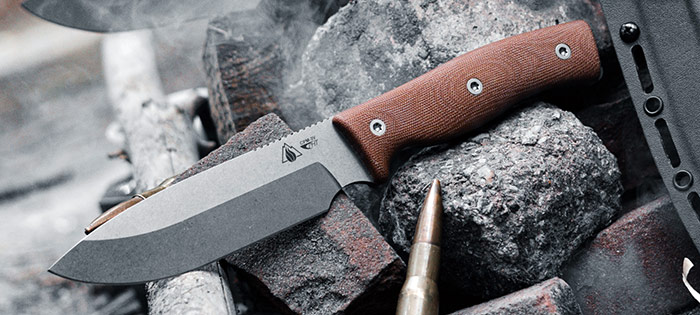
At 5.8” in blade length and 11.4” overall, the GSO 5.1 is useful as a camp knife or a hunting knife, and with 0.19” of blade steel at the spine, you don’t have much to worry about beating this through a piece of wood to start a fire. Steel choices are suitably high-end: you can choose either CPM 3V tool steel or CPM Magnacut, depending on your use case. 3V is a high-alloy particle metallurgy tool steel with arguably the best impact toughness of any regularly available blade steel as well as exceptional edge retention, but minimal corrosion resistance. Magnacut is a new particle metallurgy stainless steel that was developed in conjunction with CRK, with higher-than-normal toughness for a stainless steel along with great edge retention (although neither up to the level of 3V.) Both are top notch choices for a knife like this.
If the blade steel choice wasn’t hard enough, there’s also 15 choices for handle materials(!) including canvas and linen micarta, as well as single or dual-color G10, so you can configure the GSO 5.1 exactly how you want it. All of them come with a custom-fit Kydex sheath, again with a choice of colors (black, OD Green, Spring FDE and Coyote Tan) with a multitude of attachment options. It’s spendy at ~$300, and the preorders sometimes go offline, but it’s worth the wait when they open back up.
TOPS B.O.B. FIELDCRAFT

4.6″
9.9″
9.9 oz
154CM
Micarta
USA
The TOPS B.O.B. Fieldcraft is a series of knives by TOPS Knives, a manufacturer of tactical and outdoor gear in Eastern Idaho, USA. The BOB stands for Brothers of Bushcraft, a coalition of seven men from across the US dedicated to teaching the skills of a woodsmen, from fire starting to shelter building and more. So, it makes sense that they have their own dedicated survival knife considering how key a knife is to so many bushcraft tasks. The B.O.B. Fieldcraft comes in two sizes- a Mini with a 3.75” blade and 8.125” overall, or the original with the 4.625” blade and 9.875” overall. The Fieldcraft is designed from the outset to be the perfect partner for the modern bushcrafter, from the ground up by people who actually do it.
To this end, the Fieldcraft uses a modified Scandi grind for a stronger blade and easier field sharpening, made from 1095 high-carbon steel. Most Fieldcrafts come with a partial coating on the blade’s flats to prevent corrosion, although the knife can be ordered without if the high-traction coating tends to get in your way – more care will be needed to prevent rust. Blade stock is a beefy 0.19” wide, made stronger by the thick Scandi grind, and the blade pattern is a standard drop point which is good at a wide array of tasks.

Full tang construction is a must, and the Fieldcraft covers its tang with contoured canvas micarta scales. These scales include a trick: a Bow drill pivot on both sides is built in to help you start a fire, and the tang extends beyond the end of the scales and acts as both a hammer pommel as well as a specially-designed strike point for a ferro rod to throw sparks. A lanyard tube passes through the rear of the scales to make it easier to retrieve the knife from its Kydex sheath, which also includes a ferro rod attachment point. There are multiple handle and blade finish options for the Fieldcraft, including the plain canvas micarta with black or urban greyscale camo finish blades, Rocky Mountain Tread micarta, two tone black and white G10, and other limited run colorways. Regardless of configuration, the Fieldmaster is a solid choice for whatever you might run into.
![]()
Other notable contenders
I have used so many survival knives over the years that it was a challenge to single out only five that were my favorites. Here’s another handful of survival knives that I also consider to be fine choices.
SOG SE38-N FORCE

The SOG Force is another great choice, and it’s pretty lightweight at just 10.5 ounces. Even though it isn’t heavy, this knife is definitely stout and durable. It features a clip point straight edge at a hefty 0.24 inches thick. The blade length is six inches, and the overall length of the knife is 11.25 inches. Made from AUS–8 stainless steel, the Force holds a decent edge but also sharpens easily.
The Force’s handle is crafted from glass-reinforced nylon (GFN), and it is ergonomically contoured with a texture that provides an excellent grip without any hot spots or abrasion. It works great for chopping, batoning, slicing, carving, and prying. The butt end of the tang can be used for breaking glass, but it does not work well as a hammering spot because of its angled edges.
SOG packs a well-designed sheath with the Force, made of nylon with a hook and loop closure and a MOLLE attachment. The knife features a lanyard hole in the handle, and SOG even includes a lanyard in the box.
SPYDERCO BUSHCRAFT G-10

Spyderco is well known for their folding tactical knives, but they’ve made a solid entry into survival knives that is worth mentioning. The Spyderco BushCraft G–10 is on the smaller side with an overall length of 8.75 inches and a blade length of 4.1 inches. The 0.140-inch-thick blade is made of O–1 steel, a tool steel with a high carbon content along with manganese, silicon, chromium, vanadium, and tungsten. This type of steel is not commonly used in survival knives, but it does have good wear resistance in a low alloy, and in fact has better wear resistance than carbon steels. Just remember that O–1 steel isn’t stainless, so it will rust if you don’t take care of it.
The black fiberglass-based laminate G–10 handle of the BushCraft is contoured and incorporates a backup lanyard hole. The pattern in the G–10 looks like wood grain, giving the knife a distinctive and beautiful look. A minor drawback to this knife is the sheath, which has a plastic insert that makes it difficult to find the “sweet” spot for inserting the knife. Still, the BushCraft is effective for all possible uses of a survival knife.
KA-BAR USMC KNIFE

This is the design that inspired all survival knives, and it is still doing its job 70 years after it first debuted. This 0.165 inch thick flat grind blade has a length of seven whopping inches, and the overall length of the knife is 11.875 inches. The knife weighs in at 11.2 ounces, a terrific weight for a survival knife. The handle comes in kraton or leather, with a powdered metal butt cap.
The clip point of the 1095 Cro-Van carbon steel blade is just thick enough to be useful for prying and penetrating, but not so thick that it hinders your ability to slice and dice. The KA-BAR USMC Utility Knife is great in the field, there are just better choices as far as designs go.
TOM BROWN TRACKER T-3
![]()
5.5″
10.8″
13.2 oz
ATS-34
Micarta
USA
CONTROVERSIAL KNIFE ALERT! It seems no other survival knife has generated more controversy than the Tom Brown Tracker T–3 which was featured in the movie “The Hunted”. Folks either love it or hate it! Designed by Tom Brown, Jr., and manufactured by TOPS Knives, the Tracker T–3 is made in the USA and for the most part performs admirably. The blade is a clip point design, flat ground, and the back edge of the blade is serrated for extra-tough chopping needs.
![]() The Tracker T–3 is 10.75 inches long overall, with a blade length of 5.5 inches. The cutting edge is 5.125“ long, and the blade is 0.21” thick, almost perfect for just about any type of use. Now this knife is a bit on the heavy side, but still under a pound at 13.26 ounces.
The Tracker T–3 is 10.75 inches long overall, with a blade length of 5.5 inches. The cutting edge is 5.125“ long, and the blade is 0.21” thick, almost perfect for just about any type of use. Now this knife is a bit on the heavy side, but still under a pound at 13.26 ounces.
The blade is made from ATS–34 stainless steel, an imported Hibachi chrome-molybdenum alloy with a very small grain size and fantastic edge retention. Consider it a Japanese version of the popular and excellent US steel 154CM, favored by top names like Benchmade.
Also, this steel has more corrosion resistance than the 1095 carbon steel used by KA-BAR’s Becker 22 or ESEE’s 6P so you’ll be less worried about rust but you do sacrifice some toughness.
The Tracker T–3’s handle is gray and made from a linen Micarta like the ESEE 6P, with a very sharp, attractive grain design molded in. The handle provides excellent finger grips, and has the perfect texture and scaling to ensure you can always keep a solid hold on the knife, even in the worst weather conditions.
The design of the blade on the Tom Brown Tracker T–3 is fairly unique, featuring both a carving or slicing edge along with a chopping surface. The chopping portion of the blade is solid and heavy enough to split large pieces of timber for firewood, and it can even chop down small trees or cut off limbs. Smaller bushcraft tasks, like carving precision snare sets or putting a point on a spear or ground stake, are still easy to accomplish using the flatter section of the blade.
Unfortunately, trying to use this knife as a skinning knife is an exercise in futility, because the blade was simply not manufactured with this use in mind. This is something you need to keep in mind and is the main drawback of this otherwise perfect survival knife.
The blade holds an edge very well, but when the time comes to resharpen it, you’ll spend a little more time than you would with 1095 steel. Also, the shape of the blade just makes sharpening more tedious, since you have to work around the edges and curves while you are putting the edge back on the blade. It can be done, sure, but be prepared for this chore.
Finally, TOPS has chosen a molded Kydex sheath, which is very loose-fitting and a bit noisy when you remove the knife. Again, this might not be to everyone’s liking.
Survival knives to avoid
Ugh, so much crap on the market today that I thought I’d leave you with some ones to steer clear of. I could go on for ever here but there are a few choices that I wouldn’t want you to waste your money on.
Morakniv Companion
First, let me say that I do like Morakniv but I see too many so called ‘experts’ out there plugging the $20 Morakniv Companion as a survival knife. Sure it’s inexpensive but I struggle to recommend this as a primary survival knife. Poor quality, blade too thin, only partial tang, handle gets chewed up easily, sheath is flimsy… need I go on? Basically this knife looks great for about 5 minutes and then it just begins to fail at everything possible. Your experience may vary but I’m not impressed.
Swiss Army Knives
I love SAK’s as much as the next guy but they just don’t measure up as a serious survival knife contender. Great for the kids’ first scouting knife…not so good for keeping you alive in the wilderness when the SHTF.
Every “Rambo” Knife Ever
But it looks so damn cool and comes with a complete fire, fishing, sewing, and bear trapping kit right in the handle! Ha. Most of these knives are junk and not worth your time or money. Don’t be swayed by the Hollywood style Rambo knife please.
That’s it folks…feel free to shoot me any feedback using the contact form.

